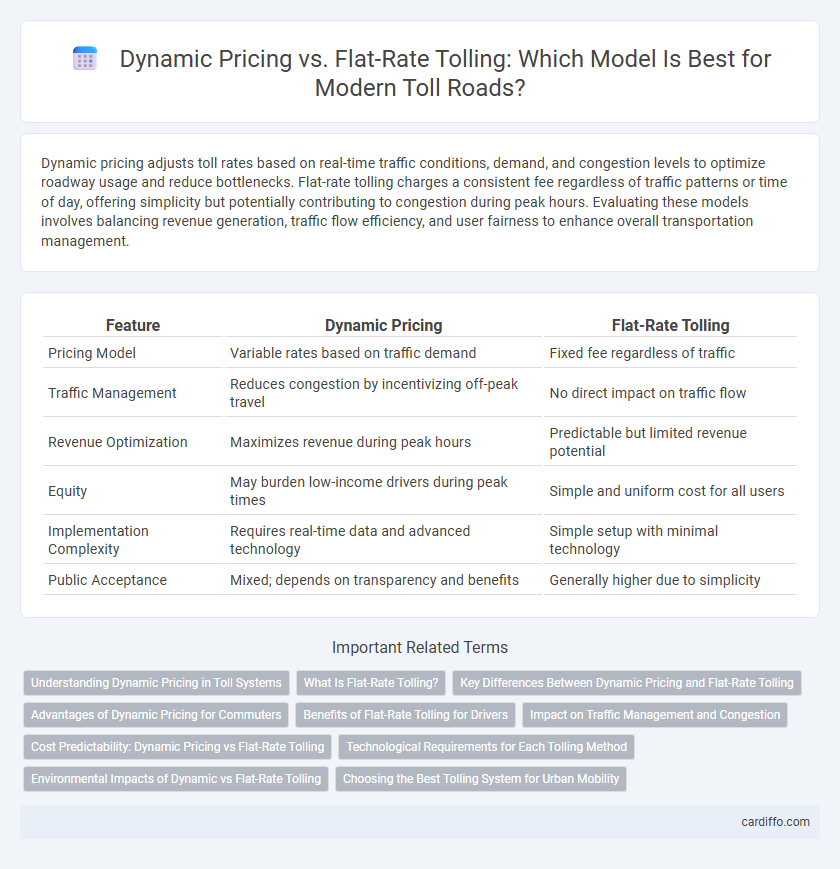Dynamic pricing adjusts toll rates based on real-time traffic conditions, demand, and congestion levels to optimize roadway usage and reduce bottlenecks. Flat-rate tolling charges a consistent fee regardless of traffic patterns or time of day, offering simplicity but potentially contributing to congestion during peak hours. Evaluating these models involves balancing revenue generation, traffic flow efficiency, and user fairness to enhance overall transportation management.
Table of Comparison
| Feature | Dynamic Pricing | Flat-Rate Tolling |
|---|---|---|
| Pricing Model | Variable rates based on traffic demand | Fixed fee regardless of traffic |
| Traffic Management | Reduces congestion by incentivizing off-peak travel | No direct impact on traffic flow |
| Revenue Optimization | Maximizes revenue during peak hours | Predictable but limited revenue potential |
| Equity | May burden low-income drivers during peak times | Simple and uniform cost for all users |
| Implementation Complexity | Requires real-time data and advanced technology | Simple setup with minimal technology |
| Public Acceptance | Mixed; depends on transparency and benefits | Generally higher due to simplicity |
Understanding Dynamic Pricing in Toll Systems
Dynamic pricing in toll systems adjusts rates based on real-time traffic conditions and demand, optimizing roadway efficiency and reducing congestion during peak hours. Unlike flat-rate tolling, which charges a fixed fee regardless of traffic volume, dynamic pricing encourages off-peak travel and better traffic distribution by varying prices throughout the day. This approach leverages data analytics and intelligent transportation systems to enhance revenue generation while improving overall traffic flow and commuter experience.
What Is Flat-Rate Tolling?
Flat-rate tolling charges a fixed fee for using a road or bridge regardless of the time of day, traffic conditions, or vehicle type, providing predictable costs for drivers. This method simplifies toll collection and reduces administrative expenses but may not effectively manage congestion or reflect demand variations. Flat-rate tolling contrasts with dynamic pricing, which adjusts tolls based on real-time traffic levels to optimize road usage and reduce peak-time congestion.
Key Differences Between Dynamic Pricing and Flat-Rate Tolling
Dynamic pricing tolling adjusts charges based on real-time traffic conditions, demand fluctuations, and congestion levels to optimize roadway usage and reduce congestion. Flat-rate tolling charges a fixed fee regardless of time or traffic, offering simplicity and predictability but potentially leading to inefficiencies during peak and off-peak periods. Key differences include price variability, traffic management effectiveness, and user cost predictability, with dynamic pricing promoting demand-based road use while flat-rate tolling maintains consistent revenue with less traffic flow control.
Advantages of Dynamic Pricing for Commuters
Dynamic pricing for tolling reduces congestion by adjusting fees based on real-time traffic demand, leading to shorter travel times for commuters. This flexible tolling strategy encourages off-peak travel, improving roadway efficiency and lowering overall commute stress. As a result, dynamic pricing offers cost savings and enhanced predictability for daily drivers compared to flat-rate toll systems.
Benefits of Flat-Rate Tolling for Drivers
Flat-rate tolling offers drivers predictable and consistent travel costs, simplifying budgeting for daily commutes and long trips. This pricing model reduces stress by eliminating unexpected fees associated with traffic fluctuations or peak travel times. Drivers also benefit from quicker toll transactions and less congestion at toll points compared to dynamic pricing systems.
Impact on Traffic Management and Congestion
Dynamic pricing adjusts toll rates based on real-time traffic demand, effectively reducing congestion by encouraging off-peak travel and optimizing road capacity. Flat-rate tolling charges a fixed fee regardless of traffic conditions, often leading to increased peak-hour congestion and inefficient road utilization. Studies show dynamic pricing improves traffic flow and decreases travel time by incentivizing variable usage patterns, enhancing overall traffic management.
Cost Predictability: Dynamic Pricing vs Flat-Rate Tolling
Dynamic pricing toll systems adjust fees based on real-time traffic demand, leading to variable costs that may challenge budget planning but optimize road usage and reduce congestion. Flat-rate tolling provides consistent, predictable costs regardless of traffic conditions, enabling easier budgeting for frequent commuters. Choosing between dynamic pricing and flat-rate tolling involves balancing cost predictability against potential travel time savings and traffic management benefits.
Technological Requirements for Each Tolling Method
Dynamic pricing tolling requires advanced sensor networks, real-time traffic monitoring systems, and AI-driven algorithms to adjust rates based on congestion levels. Flat-rate tolling relies on simpler infrastructure such as fixed electronic toll collection points and basic vehicle identification technologies. Implementation of dynamic systems demands higher computational power and data analytics capabilities to ensure accurate and timely price adjustments.
Environmental Impacts of Dynamic vs Flat-Rate Tolling
Dynamic pricing in tolling reduces traffic congestion by encouraging off-peak travel, decreasing vehicle emissions and improving air quality compared to flat-rate tolling, which often leads to constant traffic volumes and higher pollution. Variable toll rates incentivize the use of alternative routes or transportation modes, resulting in lower carbon footprints and less fuel consumption. Flat-rate toll systems lack this flexibility, making them less effective at mitigating environmental impacts caused by urban traffic congestion.
Choosing the Best Tolling System for Urban Mobility
Dynamic pricing tolling adjusts charges based on real-time traffic conditions, reducing congestion and promoting efficient road usage by incentivizing off-peak travel. Flat-rate tolling offers predictable costs and straightforward implementation but may fail to address traffic variability and peak-time demand effectively. Urban mobility benefits most from dynamic systems that optimize traffic flow, lower emissions, and enhance commuter experience through adaptive pricing strategies.
Dynamic pricing vs flat-rate tolling Infographic

 cardiffo.com
cardiffo.com